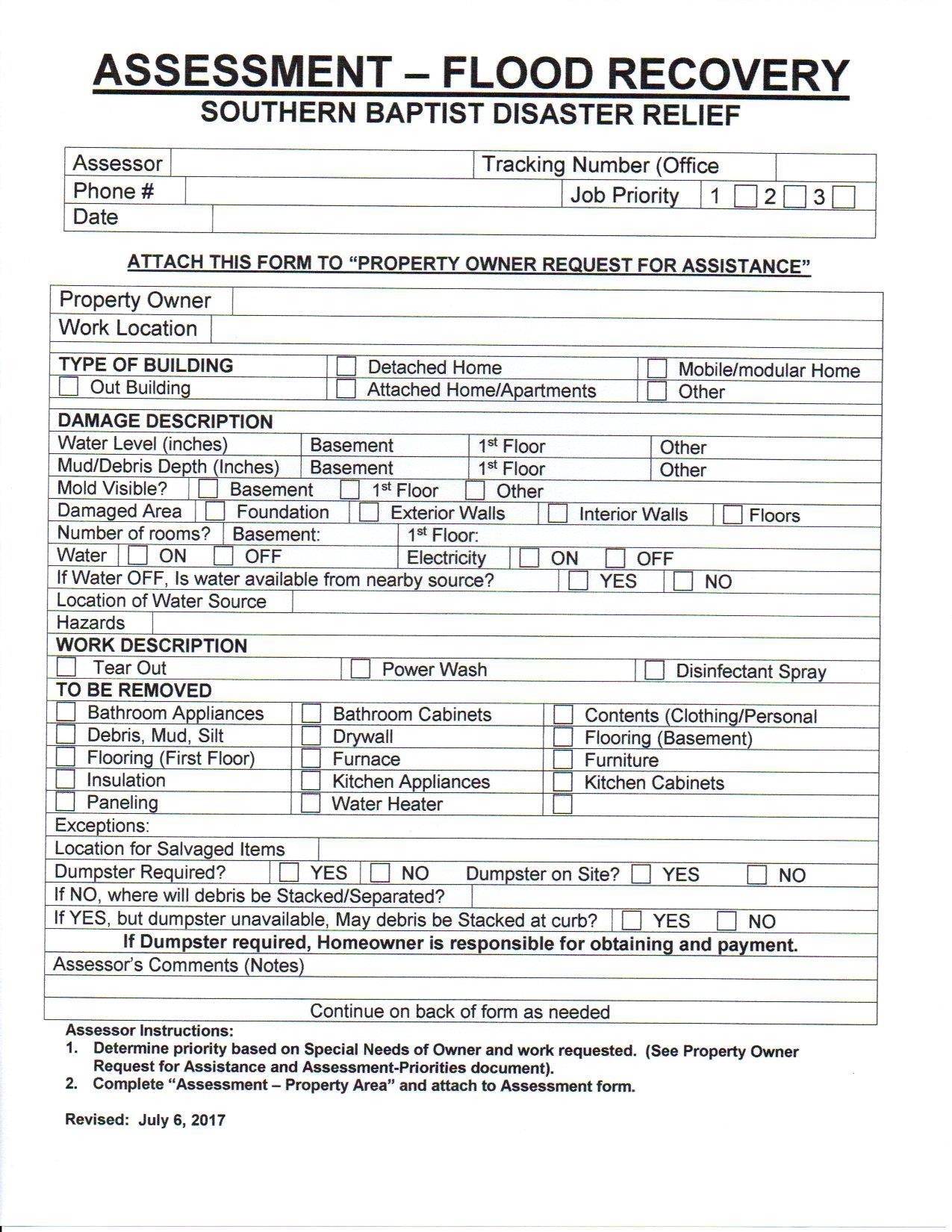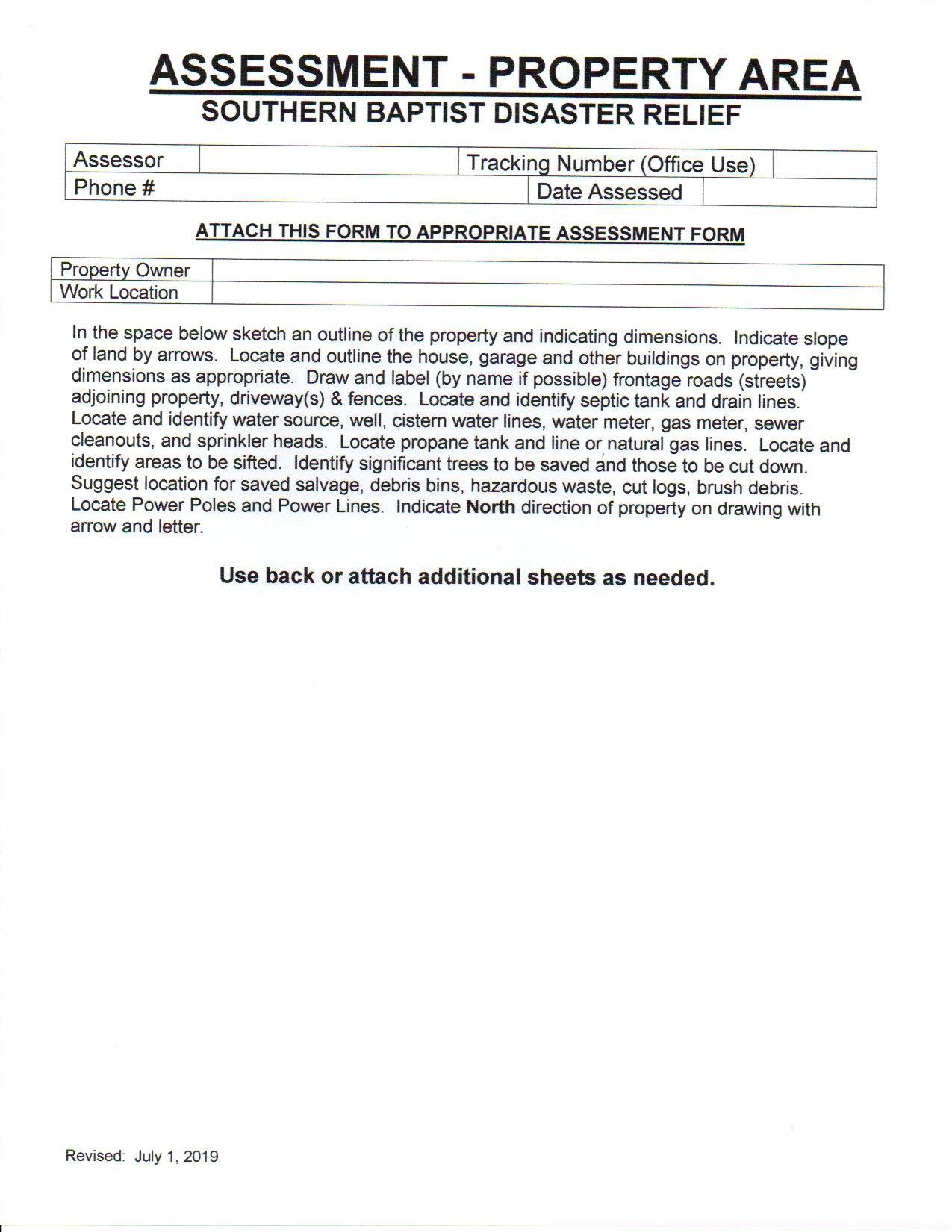

Mission Statement:
Southern Baptist Disaster Relief is a Christcentered partnership of national, state and associational ministries serving through the local church to bring help, healing and hope to individuals affected by disasters.


Vision Statement:

Southern Baptist Disaster Relief will be a welldefined, unified disaster response organization, demonstrating the love of Christ by providing physical and spiritual help to those affected by disasters.
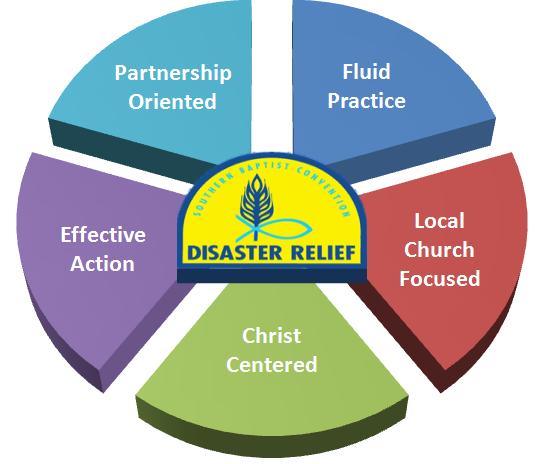
Introduction
• Southern Baptist Disaster Relief (SBDR) is a Christ-centered partnership of national, state and associational ministries serving through the local church to bring help, healing and hope to individuals affected by disasters.
• SBDR began in Texas in 1967 and has grown to be one of the largest and most respected disaster organizations in the U.S. and around the world.
• Flood Recovery is a vital component of the Disaster Relief Recovery Ministry.
Bible Verses
Unless otherwise noted, all scriptures are taken from the Christian Standard Bible copyright 2017 by Holman Publishers (HCSB). Used by permission.
Galatians 6:9-10
9 So we must not get tired of doing good, for we will reap at the proper time if we don’t give up. 10 Therefore, as we have opportunity, we must work for the good of all, especially for those who belong to the household of faith.
Philippians 2:13
13 For it is God who is working in you, enabling you both to desire and to work out His good purpose
Matthew 25:40
40 “And the King will answer them, ‘I assure you: Whatever you did for one of the least of these brothers of Mine, you did for Me.’
Ephesians 4:2
2 with all humility and gentleness, with patience, accepting[a] one another in love
Section 1: General Information Work Request Priorities
• Every work request is assigned a Priority by the Assessment team to aid the IMT in prioritizing the work. The priority is generally based on the people and circumstances and not necessarily the work. The work of the Flood Recovery team is the same regardless of the work request Priority. Remember, we are here to minister to hurting people which sometimes will override all other priority issues.
Flood Recovery
• Flood Recovery is known by various names including muck out, mudout, and cleanout all of which refer to the process of preparing a home for rebuild after being impacted by Flood water. This process of “cleaning” involves removal of mud, debris, drywall, fixtures, clothes, furniture, and other items from the structure, possible power washing, and spraying with a disinfectant solution.
• There are two (2) general rules for Flood Recovery.
o Everything touched by Flood water must be removed OR sanitized.
o When in doubt – Take it out (With Owners Permission)
• The purpose of the Flood Recovery ministry, in the process of meeting the physical needs of the homeowner, is having opportunities to share the Love of Jesus.
SBDR FLOOD RECOVERY MANUAL
Heavy Equipment
• Heavy Equipment includes tractors and skid steers.
• Heavy Equipment are generally stand-alone units supporting the Flood Recovery unit.
• Skid Steers and tractors can be used to pick up and move debris.
• The use of Heavy Equipment in Flood Recovery is dependent on the nature of the deployment and is not required in most Flood Recovery deployments.
• The use of Heavy Equipment can increase the efficiency of a Flood Recovery unit and allows the completion of additional work requests.
Before You Go
• Have a humble servant spirit
• Prepare spiritually and mentally
• Recognize severity of situation
• Be prepared to work long, hard hours under difficult conditions
• Know your physical limits
• Be prepared to share the Love of Jesus
• Be a Team Player
• Remember - God deserves all the credit
What to Bring
• Bible, devotional and reading material
• Keep a Journal
• Personal care items, towels, wash cloths etc.
• Full sleeping gear
• All medications and insurance card
• Good sturdy comfortable boots
• Insect repellent and sunscreen
• Flashlight
• Work clothes (seasonal). No shorts or sneakers during work hours.
• Comfortable clothes for after work hours
• Sleep wear
• Cell phone and charger
Important Websites
• FEMA
o www.fema.gov
• CDC (Center for Disease Control)
o www.cdc.gov
• Shock Wave
o www.fiberlock.com
Section 2: Flood Recovery Information/Definitions Flood Water
• Water that travels and brings contaminants into the home. Contaminants stay in the home after the water has receded.
SBDR FLOOD RECOVERY MANUAL
Flood Recovery Defined
• Meet the needs of persons affected by disaster.
• Remove mud, debris, drywall, fixtures, clothes, furniture, and other items from structures, power wash, and disinfect.
• Separate debris into appropriate stacks.
• Clean and disinfect structures in a safe manner.
• Be prepared for the unexpected.
• Be flexible.
Mold
• Mold is generally present after a flood and can be recognized by:
o Sight – Walls may be discolored
o Smell – Odor such as musty, earthy or foul
• Mold presents a significant health hazard.
• Mold spores will probably be in the air
• Mold spores may cause allergic reactions.
• Always assume mold is present.
Section 3: Unit and Team Structure Flood Recovery Unit
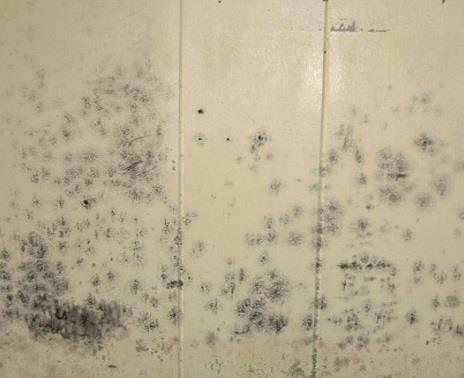
• It is recommended that the Flood Recovery unit be a towable trailer. This will allow different vehicles to pull the unit. It also reduces the insurance requirements for the unit and increases the number of drivers available. The size of the trailer will depend on the amount and weight of equipment and the capabilities of the team.
Unit Leader (Blue Cap)
• The Unit Leader should be an experienced Flood Recovery volunteer who has completed the designated Unit Leader and Flood Recovery training and wears the Blue Cap for easy recognition of leadership of the team.
• The Unit Leader is responsible for all team activities during deployment and for the safety of all volunteers, homeowners, and homeowner’s personal property at the work site.
• The Unit Leader should participate in a daily briefing with the IMT to receive the latest information related to the Flood Recovery operations and receive work requests
• Review “Assessment – Flood Recovery”, “Property Owner’s Request”, and “Assessment – Property Area”, prior to beginning work.
• Confirm address and have owner sign the “Property Owner Request” if it has not been signed.
• Be an individual that knows that it is “All about Jesus” and has a positive Christian walk.
Team Members (Yellow Cap)
• All team members should wear a yellow hat, no matter his/her training or qualifications.
SBDR FLOOD RECOVERY MANUAL
• Yellow cap team members are an integral part of the overall safety and success of the team.
• When in doubt – ask the Blue Cap.
• Be an individual that knows that it is “All about Jesus” and has a positive Christian walk.
General
• Be flexible in the assigned tasks and ready to make adjustments. It is difficult to adequately list all tasks. Teams should be prepared to meet existing needs.
• Remember, “It is not about production, it is about your testimony.” Flexibility is the key to success. Remember also that every assignment could be an opportunity to share the love of Jesus Christ.
• Be informed. Deal with information in a positive way. Never be part of misinformation.
• Be responsive in an intelligent, careful, supportive and effective manner.
Daily Meetings
• Teams will meet for devotion and debrief each day. This leads to better team effectiveness and communication.
• Morning devotion (10 to 15 minutes) may be led by team chaplain or team member, or could be led by the Incident Commander (White Cap) for the entire operation.
• Evening debrief, may be led by the White Cap for the entire operation, if not debrief should be led by the Unit Leader and should include a time of devotion and prayer
• Prayer time should include the disaster survivors, the Recovery Operation, and your individual team and team leaders.
Section 4: Site Evaluation and Set Up Arrival
• Determine best location for trailer and supporting equipment.
• Pray over the site and with homeowner.
• Determine and discuss any onsite hazards and the overall plan for the site.
• Designate two (2) people to call for help if needed.
• Assign First Aid person
• Ensure the homeowner has signed the “Property Owners Request for Assistance”.
• With homeowner assistance, decide on placement of saved items and debris.
o The IMT should provide any rules and regulations about debris placement.
o Saved items, when possible, should be placed in a protected, secure location.
o Debris will be placed in the appropriate stack.
• If a dumpster is required, it is the homeowner’s responsibility to obtain.
Set Up
• Set up wash station (use 1 oz bleach per gallon of water)
• Set up break area.
• Determine First Aid location.
• Determine Sanitation Station location.
SBDR FLOOD RECOVERY MANUAL
• Ensure Flood Recovery team is at the right house.
• Examine structure for damage before entering or working including floors, ceilings, walls, and loose objects that might fall. If there is a question about the integrity of a building, wait until local building authorities have inspected the building before entering. Notify IMT of situation.
• Review with the homeowner what we do when we ‘clean” homes including the health hazards that may be present if the interior walls have had water and mud between them. Explain that the type of mold that grows from floodwaters can cause serious health problems
• Explain to the homeowner the plan for his home.
• Have prayer with the homeowner and team
• Walk carefully through the structure. Floors may be slippery or weakened.
• Allow homeowner to decide which articles are to be salvaged and which are to be discarded.
• Formulate plan for items damaged by the flood that might pose a health hazard but homeowner wants to keep those items
While You are There
• Be sensitive to those affected by the disaster.
• Be quick to listen.
• Remember all possessions are precious.
• Guard against careless remarks.
• It is all right to cry. Seek out the Unit Leader or Chaplain if overwhelmed by the situation.
• Don’t miss divine appointments
• Be prepared to share a testimony.
• Do not take anything from the site you did not bring to the site.
• Never attempt to meet needs that you are not trained to meet.
• Be sensitive to their loss, which will most often be everything due to the contamination of the water, mud, and other substances.
• You are representing the Lord and His church. Your attitudes and actions should always reflect God’s Love.
Start of Work
• Start assigned task.
• Watch out for each other, safety is key.
• Take breaks as needed.
Completion of Work
• Review completed work with homeowner
• Clean tools and reload unit
• Pray and present Bible to Homeowner
Section 5: Flood Recovery Process General
• Shovel or carry out mud and silt
• Remove items impacted by flood water
SBDR FLOOD RECOVERY MANUAL
• Expose surfaces that flood water touched
• Place the debris in three piles at the curb (not on the water meter)
o (1) Furniture and appliances
o (2) Building materials
o (3) Chemicals and hazardous materials
✓ Solvents/Fuels/Oil
✓ Pesticides
✓ Paint/Thinners
✓ Ammunition
• Place the saved items in a protected location,
• Sweep and Vacuum
• Power Wash
• Disinfectant Spray
• Pray and present Homeowner with Bible
o Bible should be signed by all team members.
Process Details
• Cabinets
o Remove all cabinets if the water line was above the counter tops.
o Upper cabinets can generally be saved.
o Lower cabinets can generally NOT be saved
• General Items
o Remove switch and receptable covers, do not break.
o Pull all nails and remove all screws.
• Furniture and Bedding
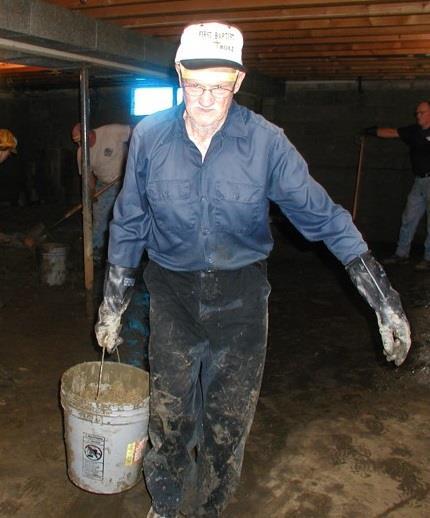

o Upholstered furniture that has been exposed to flood water should be discarded.
o Mattresses that have been exposed to flood water should be discarded.
• Flooring
o Remove and dispose of all floor coverings down to the subfloor including ceramic, vinyl and carpet.
o Carpet should be cut into small strips to make removal easier.
• Walls
o Dry Wall
✓ Cut 1 foot above OR nearest joint OR as needed (Note: Drywall products are generally 48 inches wide).
✓ Chalk a line
✓ Cut don’t break
o Paneling
✓ Remove all paneling that has been exposed to flood water. Do not cut.
o Plaster

✓ Remove plaster, lathes and screws. Treat like drywall.
o Insulation
SBDR FLOOD RECOVERY MANUAL
✓ Inspect all insulation in walls to determine amount affected by water wicking up the walls. Remove all insulation that is wet. Water will wick up the wall in the insulation so insulation may be wet several inches above the water line.
• Clothing
o Clothing may generally be salvaged, if homeowner desires, by appropriate laundry or cleaning. (Always look for molding).
• Dishes
o Dishes may generally be salvaged, if homeowner desires, by appropriate washing with a disinfectant solution.
• Appliances
o Appliances such as stoves, ovens, dishwashers, freezers, washing machines, dryers, water heaters, furnaces, AC units, and refrigerators that have been exposed to flood water should be discarded.
o Stinky Fridges
o Do not open freezers or refrigerators that have been exposed to flood water. Appliances should be taped closed and moved to the debris location.
• Power Wash
o Determine best path to dispose of power wash water.
o Power wash entire area beginning at the flood level and working downward. Use wet vacuum, mops, squeegees, and brooms to remove excess water.
• Disinfect Spray
o Disinfect entire area beginning at flood level. Shock Wave is the preferred Disinfectant solution. Hand held, back pack, or battery-operated sprayers may be used. Shock Wave should be mixed at 4oz of Shock Wave per gallon of water.
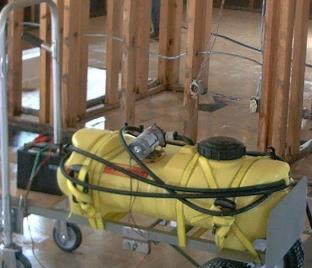
Section 6: Mold Mitigation
Shock Wave
• Mixture

o Four (4) ounces of concentrated Shock Wave per gallon of water.
o Each gallon of mixture will cover approximately 1000 square feet of surface area.
• Safety Information
o Never mix with other products.
o EPA Registered Product.
o Avoid prolonged skin contact – always wear eye protection, rubber gloves, long sleeves, and appropriate N95 mask.
SBDR FLOOD RECOVERY MANUAL
• General Information
o Product should be sprayed on all surfaces to the point of run off.
o Product requires 10 minutes “wet” time to be effective. Product is a “snapshot” mold killer (99+% effective in 10 minutes). There is very little residual effect.
o Structure does not have to be dry before spraying. Product may be applied immediately after power washing.
o Occupants should not be in structure during spraying. Occupants may return after surfaces are dry to the touch.
o Product may be applied with an agriculture type sprayer, cold mister, or hot fogger.
o Mold can “restart” at any time due to climate and structure conditions.
• Shelf Life
o Unopened container – Indefinite – Protect from freezing.
o Mixture – 64 days.
o Opened container - 2 Years – Protect from freezing.
o Mixture strength can be tested by Litmus Strip.
• Disposal Information
o Mixture and concentrate (less than 5 gallons) may be poured in drains or storm sewer with large amounts of additional water.
Bleach
o Mixture
✓ One cup regular bleach per gallon of water.
o Safety Information
✓ Never mix with other products.
✓ Insure good ventilation.
✓ Avoid skin contact – always wear eye protection, rubber gloves, long sleeves, and appropriate respiratory protection (as required based on factors such as ventilation). As a minimum, an N95 mask should be worn.
o General Information
✓ Bleach should have a strong chlorine smell. If not, the product should not be used.
✓ Product should be sprayed on all surfaces to the point of run off.
✓ Structure does not have to be dry before spraying. Product may be applied immediately after power washing.
✓ Occupants should not be in structure during spraying. Occupants may return after surfaces are dry to the touch.
✓ Product should be applied with an agriculture type sprayer.
✓ Mold can “restart” at any time due to climate and structure conditions.
o Shelf Life
✓ Unopened - 1 Year.
✓ Opened container – various. Depends on storage area temperature. Discard at end of deployment.
✓ Mixture – Do not save unused mixture.
✓ If available, mixture can be tested by Litmus strip.
o Disposal
✓ Out of date bleach and unused bleach mixture may be poured in drains or storm sewers with large amounts of additional water.
Section 7: Safety Information General
• In assessing your own situation and making decisions about safety, crews must be the primary concern. Know your limitations. Many well-intentioned volunteers have been injured during operations simply because they did not pay attention to their own physical and mental limitations. You must know your limits and monitor your condition. Fatigue leads to injury.
• Hazards – Be alert for hazards, such as sharp objects, dust, hazardous materials, power lines, leaking natural & LP gas, high water, fire hazards, and unstable structures. If water is present, check the depth before entering. Never enter rising water.
• Work in coordination with others on site
• Be aware of where other volunteers are and be concerned for their safety before throwing something out a window or using equipment
• All volunteers should be aware of potential Electrical hazards:
o Always assume that all power lines and conduits are energized
o Power back feed
o Proper grounding
o Never turn power on without notifying all persons in the area.
• Wear protective clothing including rubber boots, if needed.
• Wear gloves and N95 mask
• Only enter structures deemed safe
• Take regular work breaks. If someone looks overly hot or tired, call for a site break
• Do not drink from city water supply (unless previously approved).
• Take a day off when needed
• Ventilate structure while working in it
• Do not operate gas engines inside structure
• Take extra care on mud slick floors
• Take debris outside as you remove it
• Probe water filled areas for holes
• Sterilize hands before eating or drinking
• Maintain hydration
o DRINK LOTS of WATER!
• Power Washers
o Pressure washing is a team effort
o High Pressure is dangerous
o Never point at another person
o Do not use for washing hands or boots
o Always use eye protection
o Always wear protective clothing
• Be aware that LP gas tanks may be loose and leaking. Leaks can be determined by spraying soapy water on fittings and connections.
SBDR FLOOD RECOVERY MANUAL
• Carry adequate lighting when entering darkened structures
• Do not work alone
• Never enter rising water
• Wash and sanitize tools and equipment and return them to the unit
• MAKE SAFETY A PRIORITY!
o Project Safety
o First Aid Kits on all jobs
o Report ALL accidents ASAP (minor or serious) to Crew Leader and Unit Leader.
• Follow safety requirements when equipment refueling is taking place
o Turn Generator off
o Turn engine off
o Allow to cool (at least two minutes)
o Do not overfill or spill
o Exercise caution
Safety Equipment
• Use appropriate personal protection equipment (PPE).
o Hard hat
o Goggles/Safety Glasses/Safety Shield
o Appropriate mask (N95) or respirator
o Work gloves
o Rubber boots
o Disposable ‘Tyvek’ type coveralls to protect regular work clothes (Optional)
Safety Rules
• Confirm that all utilities have been turned off before entering a damaged building, especially in wet areas. Stand on dry area while turning electrical switches off in wet areas.
• When entering a flooded area, assume the area is contaminated. Graves may have been opened; septic and sewer systems will overflow; household cleansers as well as other products often found around a home pose a health risk. LP gas tanks may be loose and leaking. Remember, LP gas gathers close to the ground.
• Normally stepping on a rusty nail would bring the risk of tetanus. In a flood situation, the nail could also carry hepatitis or potentially deadly diseases. Therefore, anyone responding to a flood disaster should have a current tetanus shot and should consider getting hepatitis shots.
• It is common in disasters to encounter wild and domestic animals that may be rabid. Snakes, and possibly even alligators, may be in spaces you would not expect them. Never reach into a space you cannot see into. Be cautious of dogs and cats wandering or approaching the area.
• Ventilate closed rooms or buildings before entering to allow escaped gas or foul odors to escape and continue to provide ventilation while working. Do not linger in areas where gas fumes are present. Be especially careful about flames or sparks where fumes are detected.
• Make certain you have good footing when using ladders and scaffolds. Be extra cautious in wet or slick areas.
• Remove ladders, scaffolds, or ropes when not in use. Do not leave tools and equipment unattended.
• In flooded areas – basements, floors, outdoor pools – probe ahead for holes or submerged objects. Use a wood pole with a dry handle.
• Avoid fatigue. Do not work on ladders or scaffolds or operate machinery when tired or on medications that cause drowsiness.
• Wear proper clothing, i.e., boots in wet areas, heavy shoes in construction areas, gloves, hard hats, long pants and sleeves. Protect yourself against the sun or cold. Wear safety equipment as required or provided.
• Provide sufficient lighting in work areas – daylight or artificial. Look first before entering areas. Check for glass, nails, or other sharp and protruding objects.
• Be aware of where other volunteers are located and be concerned for their safety before throwing something out a window or using equipment.
• Assume fallen electrical lines are live until notified by utility companies that current is off (also phone service and cable TV). Continue to use caution because of possible improper use of electric generators in nearby homes.
• Prevent health hazards by cleaning areas where decay, mildew, or chemicals odors may result from wetness or perishables, such as food.
• Only experienced persons should operate power machinery. Follow safety requirements when refueling is taking place. Never operate gas power equipment indoors.
• Designate a first aid coordinator.
• Make safety and hygiene a priority. Get adequate rest, fluids, and nourishment so you can achieve maximum effectiveness.
• Personal cleansing
o Take boots and gloves to assigned area to be cleaned. Also, clean equipment (tool, shovels, etc.).
o Keep clean clothes in a plastic bag at housing site.
o Take regular showers and dress in clean clothes.
o Place contaminated clothes in a plastic bag and return clothes to designated location to be laundered in disinfectant–very important.
o Protect seating of transport vehicles, as needed.
• Lifting should always be done in a way that protects the back from strain or other injury. To lift safely:
o Bend your knees and squat.
o Keep the load close to your body.
o Keep your back straight.
o Push up with your legs.
Section 8: Helpful Hints
• Wear suitable rain gear and rubber boots while spraying or pressure washing.
• Use rubber gloves and wear goggles when handling bleach and other disinfectants.
• Work within your strengths and limitations – physical (strength and health), emotional (stress management), and mental (knowledge and skills).
• Use hand sanitizer before consuming anything or wash hands with bleach and water mix.
• Disinfect tools used each day upon completion of work. At the end of the day, dispose of all used mop heads and sponges.
• Eat regularly and increase water intake according to heat and workload. Take snacks and bottled water to site. Take appropriate precautions to clean hands before getting snacks, water, and meals.
• Rest when you can. Some people can work longer than others. Gauge yourself. Do not be intimidated by what others do if it affects your strength and usefulness. Sleeping may be difficult. Try to arrange what is best for you.
• Dispose of any articles that are punctured (such as gloves and boots).
• Do not open refrigerators and freezers. Duct tape doors and keep them shut.
• If you are unfamiliar with motorized tools, do not attempt to use them until properly trained.
• Make safety a priority so that you can achieve maximum effectiveness, not only for you but also your team.
Section 9: Draining a Basement
• Water in the ground outside a building is pushing hard against the outside of the basement walls. The water inside the basement is pushing right back.
• If the basement is drained too quickly, the pressure outside the walls will be greater than the pressure inside the walls, which may make the walls and floor crack and collapse, causing serious damage.
• Follow these steps to pump water out of a basement without causing damage:
o Never go into a basement that has water standing in it unless you are sure the electricity is off.
o When the floodwaters are no longer covering the ground, you can start pumping the water out of the basement.
o Pump the water level down to two to three feet. Mark the level and wait overnight.
o Check the water level the next day. If the water went back up or covered your mark, it is still too early to drain the basement. Wait 24 hours. Then pump the water down to two to three feet again. Check the level the next day.
o When the water stops going back up, pump down another two to three feet and wait overnight. Repeat previous steps until all the water is pumped out of the basement.
Don’t be part of the problem, Be part of the solution.
SBDR FLOOD RECOVERY MANUAL
Optional
Air Compressor, hoses and accessories
12-volt Battery Charger
Chainsaw, supplies, accessories, safety equipment
Coveralls
Hoe, Flat
Pump, Submersible, Electric
Pump, Sump, Electric
Rain Gear
Rakes, Metal Rubber Boots
Tarps
Water Cut Off Tool
Work Platforms

